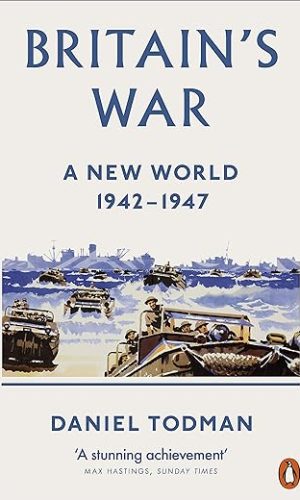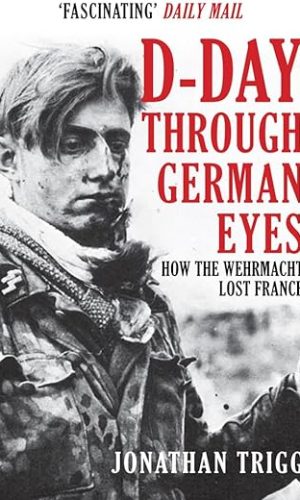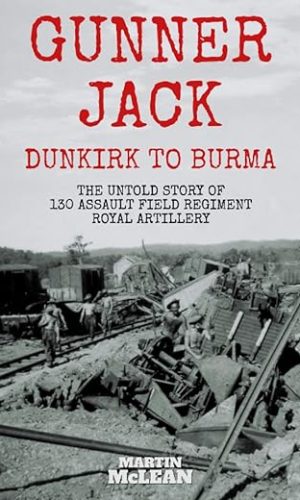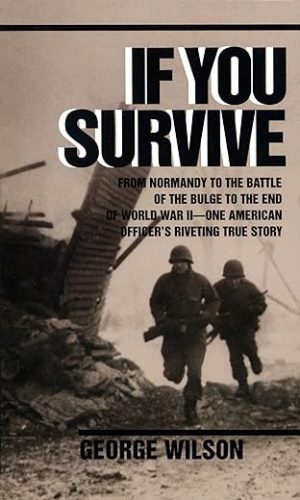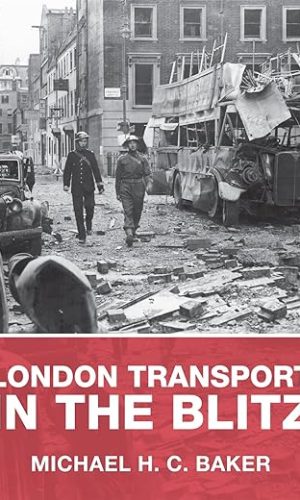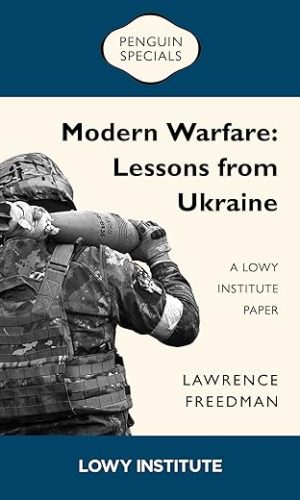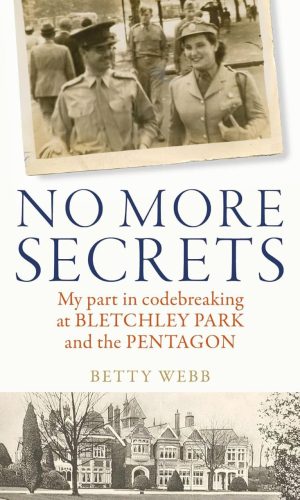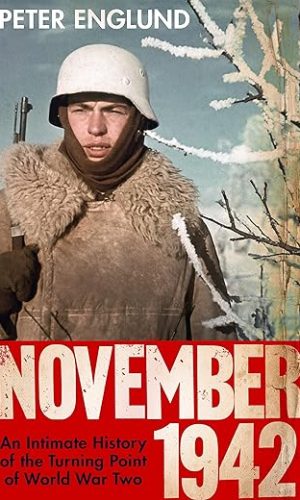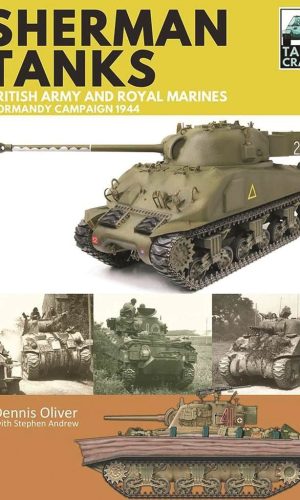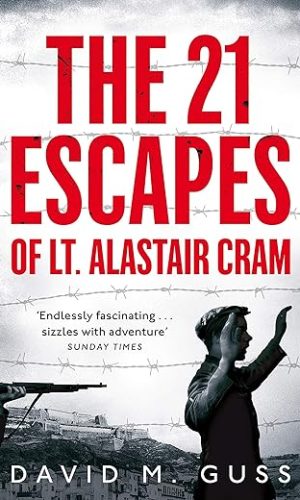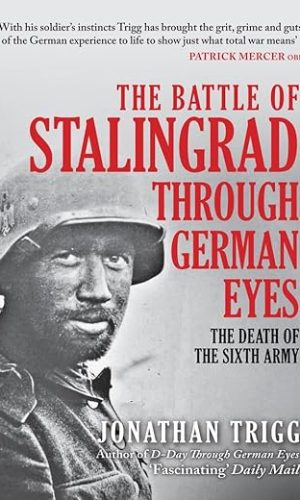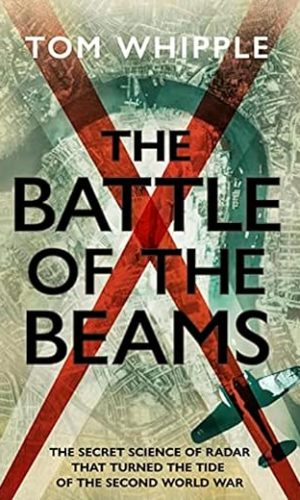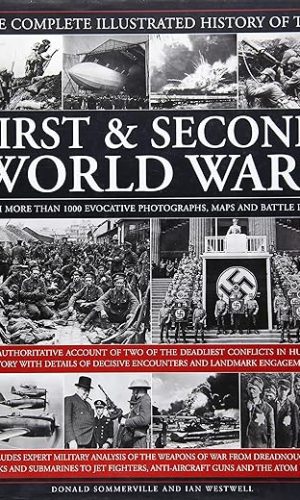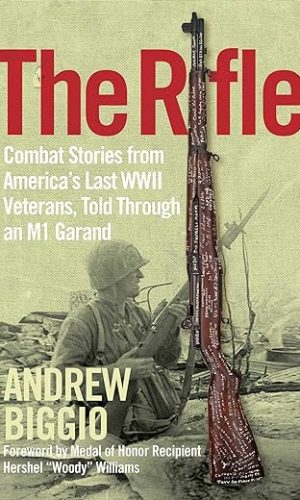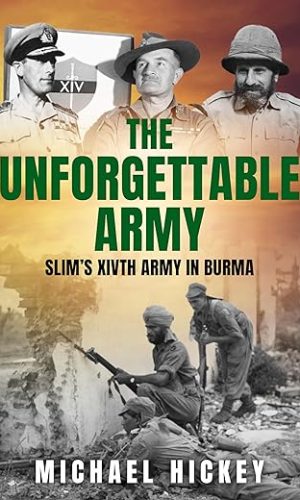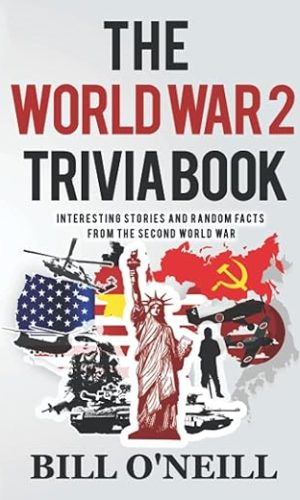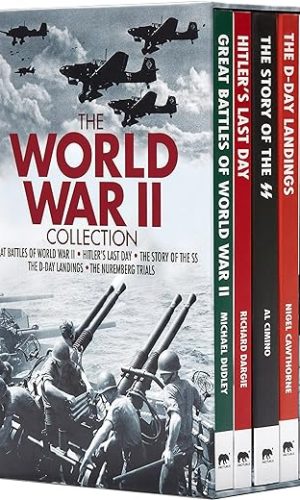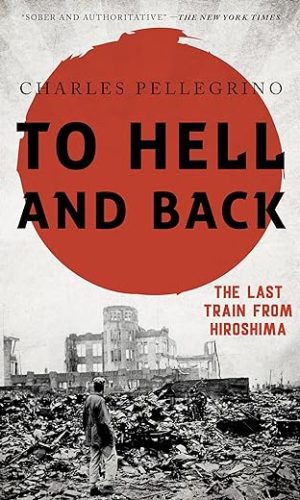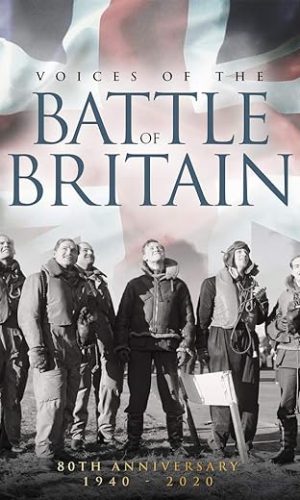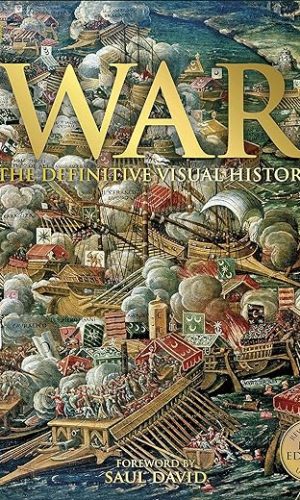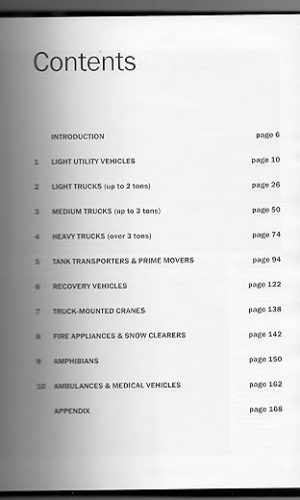World War II 1939-1945
-
Britain’s War: A New World, 1942-1947
WINNER OF THE TEMPLER MEDAL BOOK PRIZE 2020
A SPECTATOR, FINANCIAL TIMES AND DAILY TELEGRAPH BOOK OF THE YEAR 2020
‘A stunning achievement’ Max Hastings, Sunday Times
Part Two of Daniel Todman’s epic history of the Second World War opens with one of the greatest disasters in British military history – the fall of Singapore in February 1942. Unlike the aftermath of Dunkirk, there was no redeeming narrative available here – Britain had been defeated by a far smaller Japanese force in her grandly proclaimed, invincible Asian ‘fortress’.
The unique skill of Daniel Todman’s history lies in its never losing sight of the inter-connectedness of the British experience. The agony of Singapore, for example, is seen through the eyes of its inhabitants, of its defenders, of Churchill’s Cabinet and of ordinary people at home. Each stage of the war, from the nadir of early 1942 to the great series of victories in 1944-5 and on to Indian independence, is described both as it was understood at the time and in the light of the very latest historical research.
Britain’s War is a triumph of narrative, empathy and research, as gripping in its handling of individual witnesses to the war – those doomed to struggle with bombing, rationing, exhausting work and above all the absence of millions of family members – as of the gigantic military, social, technological and economic forces that swept the conflict along. It is the definitive account of a drama which reshaped our country.
‘I cannot recommend this history highly enough’ Keith Lowe, Literary Review
Read more
£13.60£16.10Britain’s War: A New World, 1942-1947
£13.60£16.10 -
Burma ’44: The Battle That Turned Britain’s War in the East
‘A thrilling blow-by-blow account’ The Times
‘A first-rate popular history of a fascinating and neglected battle… a veritable page-turner’ BBC HistoryIn February 1944, a rag-tag collection of clerks, drivers, doctors, muleteers, and other base troops, stiffened by a few dogged Yorkshiremen and a handful of tank crews managed to hold out against some of the finest infantry in the Japanese Army, and then defeat them in what was one of the most astonishing battles of the Second World War.
What became know as The Defence of the Admin Box, fought amongst the paddy fields and jungle of Northern Arakan over a fifteen-day period, turned the battle for Burma. Not only was it the first decisive victory for British troops against the Japanese, more significantly, it demonstrated how the Japanese could be defeated. The lessons learned in this tiny and otherwise insignificant corner of the Far East, set up the campaign in Burma that would follow, as General Slim’s Fourteenth Army finally turned defeat into victory.
Burma ’44 is a tale of incredible drama. As gripping as the story of Rorke’s drift, as momentous as the battle for the Ardennes, the Admin Box was a triumph of human grit and heroism and remains one of the most significant yet undervalued conflicts of World War Two.
The new, sweeping World War II book from James Holland, THE SAVAGE STORM, is available for pre-order now.
Read more
£7.30£10.40 -
D-Day Through German Eyes: How the Wehrmacht Lost France
Everyone is familiar with the story of D-Day and the triumphal liberation of France by the Allies: a barbaric enemy was defeated by Allied ingenuity, courage and overwhelming military force, helped by dreadful German command errors and the terrible state of Wehrmacht forces in the West – but is this all true? The Wehrmacht was hugely experienced, equipped with some of the best weaponry of the war and was holding its own in Italy and Russia at the time. Berlin knew the invasion was coming and had had years to prepare for it. So how did the Germans view the impending invasion and campaign, did they feel ready, what forces did they have and could they have done better? Previous histories have focused on the ‘clash of the generals’; the battle between von Runstedt and Eisenhower, Montgomery and Rommel, but on the German side in particular this was a battle that would be fought by divisional and regimental commanders; the ‘German D-Day colonels’ upon whom the real business of trying to defeat the invasion fell – it was they and their men, outnumbered and outgunned, who somehow held Normandy for ten whole weeks against the greatest seaborne invasion force ever assembled, and occasionally even came close to defeating it. In the end they lost, and the majority of these unsung leaders ended up killed, wounded or captured in the fighting. As for their men, they ranged from élite Waffen-SS stormtroopers through to bewildered teenagers, old men, ‘recycled’ invalids and even anti-communist Eastern legions. Written from the ‘other side’ and told through the words of the veterans, this book is a revelation.Read more
£8.70£9.50 -
Faithful Through Hard Times: The uncensored story of WW2 Malta
“This is a moving story played out by every serving soldier when war dislocates families and taxes friendships.” Colonel (retired)Walter Bonnici, RAMC
Four years, 3 million bombs, one small island out-facing the might of the German and Italian air forces – and one young Scotsman who didn’t want to be there. The true story of WW2 Malta from an eye-witness account written at the time in a secret diary, a diary too dangerous to show anyone, and too precious to destroy.
Private George Taylor arrived on Malta in 1940 thinking that shiny buttons would earn him fast promotion; he left four years later, a cynical sergeant and a Master Freemason who never said, ‘I was there, ‘ without a bitter smile. Despite the times he said, ‘It’s me for the next boat’, despite his fears that Nettie had forgotten him, George kept the motto of the Royal Army Medical Corps ‘In arduis fidelis’, ‘faithful through hard times’ and only told his diary the inside story of four long years.
Now, the truth can be told.
‘Based on words and feelings recorded at the time it is probably unique.’ Don Marshall, Military History Enthusiast
www.jeangill.com
Read more
£2.90 -
Forgotten War: The British Empire and Commonwealth’s Epic Struggle Against Imperial Japan, 1941–1945
The monumental struggle fought against Imperial Japan in the Asia/Pacific theater during World War II is primarily viewed as an American affair. While the United States did play a dominant role, the British and Commonwealth forces also made major contributions – on land, at sea and in the air – eventually involving over a million men and vast armadas of ships and aircraft. It was a difficult and often desperate conflict fought against a skilled and ruthless enemy that initially saw the British suffer the worst series of defeats ever to befall their armed forces. Still, the British persevered and slowly turned the tables on their Japanese antagonists. Fighting over an immense area that stretched from India in the west to the Solomon Islands in the east and Australia in the south to the waters off Japan in the north, British and Commonwealth forces eventually scored a string of stirring victories that avenged their earlier defeats and helped facilitate the demise of the Japanese Empire.Often overlooked by history, this substantial war effort is fully explored in Forgotten War. Meticulously researched, the book provides a complete, balanced and detailed account of the role that British and Commonwealth forces played on land, sea and in the air during this crucial struggle. It also provides unique analysis regarding the effectiveness and relevance of this collective effort and the contributions it made to the overall Allied victory.
Read more
£20.10£23.80 -
Gunner Jack Dunkirk to Burma: The Untold Story of 130 Assault Field Regiment Royal Artillery
‘Churchill needed a victory and it was decided that we were just the lads to do it, and retake Burma without aircraft, just brute force and ignorance.’
– Alf Smith, D Troop, 316 Battery, 130th (Lowland) Field RegimentThe Lowlanders had a hell of a war. Despatched to the far side of the globe to face the merciless might of the Imperial Japanese Army, this steadfast band of volunteers and conscripts endured operations that are now all but forgotten, overlooked in even the most comprehensive published histories of the Second World War.
They were ordinary men facing extraordinary horrors, a gang of amateurs forged into a crack unit that took on some of the Royal Artillery’s toughest engagements in Burma. Drawing upon hundreds of archive documents, unpublished memoirs and declassified reports, their astonishing story of hardship, humour and heroism is told here for the first time. This painstakingly-researched book traces their journey from enlistment to demob, examining the battles they fought, the way they lived, and the triumphs and tragedies they experienced along the way. It weaves together the grand strategies of politicians and generals with first-hand accounts from those at the sharp end, from the gunners on the ground, to the infantry they supported, to the pilots battling for the skies above them.
‘Screaming shells were exploding everywhere. I threw myself hard against a fallen tree and could hardly believe it was our own guns… I could feel my body being violently compressed with every explosion. The pungent smell of cordite was everywhere while the shrapnel whined all around us.’
– Bill Bryden, F Troop, 494 Battery, 130th (Lowland) Field RegimentThe narrative follows Jack McLean, who as a reckless teenager joined his local Territorial Army unit (139th Field Regiment: the Lewisham Gunners) shortly before the outbreak of the Second World War. Sent to join the British Expeditionary Force in France, after gamely standing on the Escaut Line against experienced German troops he was evacuated through Dunkirk. As Britain braced for invasion, young Jack was ordered to join the untested 130th (Lowland) Field Regiment to offer it the benefit of his ‘battle experience’.
Despite a faltering start with antiquated equipment, the Lowlanders were soon sent over the ocean to take part in the first foray back into Burma after the Japanese invasion. They were hardened in the Somme-like slaughter of Donbaik and, as 1943’s ill-fated Cannibal expedition descended into catastrophe, fought for their lives on the palm-fringed shores of the Bay of Bengal, surrounded on the beach with their backs to the sea.
‘The gunners leaned out with their rifles at the ready. If ever men prayed hard, we who watched did then. Lurching and heaving, the good old ‘Quad’ waded through, and the gunners, yelling like mad, opened fire with their rifles as they passed the ill-fated copse.’
– Ronnie Nicholson, Regimental Headquarters, 130th (Lowland) Field RegimentLater, as an experimental ‘assault’ regiment in a unique Combined Operations formation, they held the line against the shock Japanese Arakan offensive of 1944. Ultimately assigned to a fractious multi-national task force headed by notorious American general ‘Vinegar Joe’ Stilwell, their war culminated in a ten-month, thousand-mile slog through monsoon rains and remote mountainous jungle to reach Mandalay, chasing a stubborn enemy rearguard through country that was eminently suited to the tactics of ambush and infiltration for which the Japanese soldier was rightly feared and admired.
Until now, surviving details of their staggering feat of human endurance have lain buried in archives, a neglected sideshow to an ill-remembered theatre of conflict; the forgotten of the Forgotten Army.
Read more
£16.10 -
Hitler, Stalin, Mum and Dad: A Family Memoir of Miraculous Survival
THE INSTANT SUNDAY TIMES BESTSELLER
‘Epic, moving and important’ ROBERT HARRIS
‘A modern classic’ OBSERVER
‘An unforgettable epic of a book’DAILY MAIL
From longstanding political columnist and commentator Daniel Finkelstein, a powerful memoir exploring both his mother and his father’s devastating experiences of persecution, resistance and survival during the Second World War.
Daniel’s mother Mirjam Wiener was the youngest of three daughters born in Germany to Alfred and Margarete Wiener. Alfred, a decorated hero from the Great War, is now widely acknowledged to have been the first person to recognise the existential danger Hitler posed to the Jews and began, in 1933, to catalogue in detail Nazi crimes. After moving his family to Amsterdam, he relocated his library to London and was preparing to bring over his wife and children when Germany invaded the Netherlands. Before long, the family was rounded up, robbed and sent to starve in Bergen-Belsen.
Daniel’s father Ludwik was born in Lwów, the only child of a prosperous Jewish family. In 1939, after Hitler and Stalin carved up Poland, Ludwik’s father was arrested and sentenced to hard labour in the Gulag. Meanwhile, deported to Siberia and working as a slave labourer on a collective farm, Ludwik survived the freezing winters in a tiny house he built from cow dung.
Hitler, Stalin, Mum and Dad is a deeply moving, personal and at times horrifying memoir about Finkelstein’s parents’ experiences at the hands of the two genocidal dictators of the twentieth century. It is a story of persecution; survival; and the consequences of totalitarianism told with the almost unimaginable bravery of two ordinary families shining through.
‘Danny Finkelstein has written an elegant, moving account of the history of one family, and in doing so shines light on the history of the 20th century. If you want to understand Hitler and Stalin, read this book about people whose lives were upended by both of them’ ANNE APPLEBAUM, author of Gulag: A History, winner of the Pulitzer Prize
Daniel Finkelstein’s book ‘Hitler, Stalin, Mum and Dad’ was a Sunday Times bestseller w/c 26-06-2023.
Read more
£20.99£25.00 -
If You Survive (Ivy Books World War II/Nonfiction): From Normandy to the Battle of the Bulge to the End of World War II, One American Officer’s Riveting True Story
“If you survive your first day, I’ll promote you.”So promised George Wilson’s World War II commanding officer in the hedgerows of Normandy — and it was to be a promise dramatically fulfilled. From July, 1944, to the closing days of the war, from the first penetration of the Siegfried Line to the Nazis’ last desperate charge in the Battle of the Bulge, Wilson fought in the thickest of the action, helping take the small towns of northern France and Belgium building by building.
Of all the men and officers who started out in Company F of the 4th Infantry Division with him, Wilson was the only one who finished. In the end, he felt not like a conqueror or a victor, but an exhausted survivor, left with nothing but his life — and his emotions.
If You Survive
One of the great first-person accounts of the making of a combat veteran, in the last, most violent months of World War II.
Read more
£6.50£7.10 -
Japan at War in the Pacific: The Rise and Fall of the Japanese Empire in Asia: 1868-1945
“By the time of Japan’s surrender in 1945, an entire generation had grown up knowing nothing but conflict; but the transformation of Japan into a militarist power began decades earlier, with the toppling of the old samurai regime, and the rush of the formerly isolated nation onto the world stage.”Japan at War in the Pacific recounts the dramatic story of Japan’s transformation from a Samurai-led feudal society to a modern military-industrial empire in the space of a few decades―and the many wars it fought along the way. These culminated in an attempt by Japan’s military leaders to create an Asia-Pacific empire which at its greatest extent rivaled the British Empire in scope and power.
The battle for supremacy in the Pacific brought the Japanese to great heights but led ultimately to the nation’s utter devastation at the end of World War II, culminating with the dropping of atomic bombs on Hiroshima and Nagasaki―the only time such weapons have been used in warfare.
In this book, author Jonathan Clements offers fascinating insights into:
- The wars that Japan fought during its rise to supremacy in the western Pacific, including the Russo-Japanese War, the seizure of Manchuria and war in China, and the Pacific theater of World War II.
- The many military actions undertaken by Imperial Japanese forces including the horrific “Rape of Nanjing,” the surprise attack on Pearl Harbor, the decisive defeat at the Battle of Midway, the savage Battles of Okinawa and Iwo Jima, and many more.
- The motivations and beliefs of Japan’s leaders, as well as the policy decisions of a government dedicated to expansion which ultimately led to a complete dismantling of the nation’s political and social order during the Allied Occupation.
- With over 75 photographs and maps, this book vividly recounts the amazing story of Japan’s military conquests. Clements charts the evolution of the Japanese empire in the Pacific and the influence of a ruthless military-led government on everything from culture and food to fashion and education―including the anthems and rallying calls of a martial nation which were silenced long ago but continue to echo in Asian politics.
Read more
£13.70£17.10 -
London Transport in the Blitz
Up until the twentieth century, wars were fought on the battlefield; it rarely impacted the civilian population. All this changed with the development of aircraft; suddenly there was an additional dimension to warfare. World War 1 saw the first limited raids on urban areas, but it was World War 2 that forced Britains towns and cities onto the front line. While many town and cities suffered severe damage, it was the greater London area that sustained the longest and most damaging onslaught from the early bombing raids of 1940 through to the V1s and V2s of the later years of the war. Central to the viability of the city during the war was London Transport; not only did its Underground stations provide essential additional air raid shelters, but its buses, trains, trams, and trolley buses had to continue to operate throughout the period, despite sustaining vast damage to vehicles and infrastructure. This book tells its fascinating story.Read more
£16.30£19.00London Transport in the Blitz
£16.30£19.00 -
Miss Dior: A Wartime Story of Courage and Couture
Miss Dior is a wartime story of freedom and fascism, beauty and betrayal and ‘a gripping story’ (Antonia Fraser).
‘Exceptional . . . Miss Dior is so much more than a biography. It’s about how necessity can drive people to either terrible deeds or acts of great courage, and how beauty can grow from the worst kinds of horror.’
DAILY TELEGRAPHMiss Dior explores the relationship between the visionary designer Christian Dior and his beloved younger sister Catherine, who inspired his most famous perfume and shaped his vision of femininity. Justine Picardie’s journey takes her to wartime Paris, where Christian honed his couture skills while Catherine dedicated herself to the French Resistance and the battle against the Nazis, until she was captured by the Gestapo and deported to the German concentration camp of Ravensbrück.
Tracing the wartime paths of the Dior siblings leads Picardie deep into other hidden histories, and different forms of resistance and sisterhood. She discovers what it means to believe in beauty and hope, despite our knowledge of darkness and despair, and reveals the timeless solace of the natural world in the aftermath of devastation and destruction.
*A beautiful, full colour package featuring over 200 archival images.*
‘Extraordinary . . . Picardie uses her investigative reporting skills . . . the result is Netflix-worthy and the pace page-turning . . . Catherine’s story shines – the quiet Dior who preferred flowers to fashion, the unsung heroine who survived the abuse of the Third Reich to help liberate France.’
SUNDAY TIMESRead more
£14.60£19.00Miss Dior: A Wartime Story of Courage and Couture
£14.60£19.00 -
Modern Warfare: A Lowy Institute Paper: Penguin Special: Lessons from Ukraine
“More than any other modern war, the fight between Russia and Ukraine has been a tough testing ground for modern weapons and operational concepts. Drawing on extensive research into the conduct of the war during its first year, Sir Lawrence Freedman assesses the contrasting strategies of the two sides. Ukraine has fought along classical lines, seeking victory through battle. Russia has adopted a more total approach, combining conventional battles with attacks on Ukraine’s socio-economic structure. Freedman explains why the apparently superior Russian force has been unable to defeat and subjugate Ukraine.”Read more
£6.20£6.60 -
No More Secrets: My part in codebreaking at Bletchley Park and the Pentagon
‘Engaging’ Daily Telegraph
The true and extraordinary story of one of the last surviving women to have worked in codebreaking at both Bletchley Park and the Pentagon.
Born one hundred years ago, Betty Webb MBE, LOH (Legion of Honour) has had a ringside seat to history. After graduating from school, she faced the usual limited opportunities for employment on offer to women at the time. However, with the war in full swing, fate intervened and in 1941, wanting to play her part in the war effort, Betty joined the Auxiliary Territorial Service (Women’s Army).
After being interviewed by an intelligence officer, she found herself at Euston station with her kit-bag, a travel warrant in her pocket and instructions to get off the train at Bletchley Park.
Between 1941 and 1945 Betty played a vital role in the top-secret efforts being made to decipher the secret communications of the Germans and later the Japanese. In 1945, as other members of the forces returned home from the war in Europe, she was sent to the Pentagon and was in Washington DC when the atomic bombs fell and when Eisenhower announced the end of the war.
Betty was unable to reveal the true nature of her work, even to her parents, until years later. In this fascinating book, she revisits the key moments of her life and recounts the incredible stories from her time at Bletchley Park.
Read more
£4.80£9.50 -
November 1942: An Intimate History of the Turning Point of the Second World War
**A Telegraph Best History Book of 2023**
‘An astonishing achievement’ ANTONY BEEVOR
‘Extraordinary’ JULIA BOYDAn intimate history of the most important month of the Second World War – perhaps the century – as experienced by those who lived through it, completely based on their diaries, letters and memoirs.
At the beginning of November 1942, it looked as if the Axis powers could win the war; at the end of that month, it was obviously just a matter of time before they would lose.
In between came el-Alamein, Guadalcanal, the French North Africa landings, the Japanese retreat in New Guinea, and the Soviet encirclement of the German 6th Army at Stalingrad. In this innovatively kaleidoscopic and riveting historical marvel, Peter Englund reduces these epoch-making events to their basic component: the individual experience.
In thirty memorable days we meet characters including a Soviet infantryman at Stalingrad; an Italian truck driver in the North African desert; a partisan in the Belarussian forests; a machine gunner in a British bomber; a twelve-year-old girl in Shanghai; a university student in Paris; a housewife on Long Island; a prisoner in Treblinka; Albert Camus, Vasily Grossman, and Vera Brittain – forty characters in all. We also witness the launch of SS James Oglethorpe; the fate of U-604, a German submarine; the building of the first nuclear reactor; and the making of Casablanca.
Not since Englund’s own The Beauty and the Sorrow has a book given us one of the most dramatic periods of human history in all its immensity and emotional range.
‘Thought-provoking’ SUNDAY TIMES
‘Thoroughly worth reading’ TELEGRAPHRead more
£19.80£23.80 -
Tank Craft 2: Sherman Tanks British Army and Royal Marines Normandy Campaign 1944
With production in excess of 55,000 the Sherman tank was eventually in service with most Allied armies of the Second World War and by the time of the Normandy landings was the mainstay of Britain’s armoured battalions. In his second book in the TankCraft series, Dennis Oliver uses wartime photos and extensively researched, exquisitely presented colour illustrations to cover the Sherman tanks used by the units of the Royal Armoured Corps and the Royal Marines during the fighting in northern France. As with all the books in the TankCraft series, a large part of this work showcases available model kits and aftermarket products, complemented by a gallery of beautifully constructed and painted models in various scales. Technical details as well as modifications introduced during production and in the field are also explained as is the complex system of markings employed by British armoured regiments. This book will give the modeller all the information and knowledge required to recreate an authentic miniature representation of the tanks that fought from the beaches of Normandy, through the battles for Caen and on to killing fields of Falaise.Read more
£12.60£14.20 -
The 21 Escapes of Lt Alastair Cram: A Compelling Story of Courage and Endurance in the Second World War
A genuinely new Second World War story, The 21 Escapes of Lt Alastair Cram by David M. Guss is a riveting account of the wartime exploits of the Scotsman. It is a tale of courage in the face of extraordinary odds and a testament to one man’s dogged determination never to give up.
‘The greatest serial escaper of the Second World War’ – The Times
‘Endlessly fascinating. Cram’s story sizzles with adventure’ – Giles Milton, Sunday Times
In November 1941 Lt Alastair Cram was taken prisoner in North Africa as a devastating tank battle unfolded as Operation Crusader struggled to relieve Tobruk. His capture began a four year-long odyssey as he passed through twelve different POW camps, three Gestapo prisons and one asylum. Determined to regain his freedom, he became a serial escapee fleeing his captors no fewer than twenty-one times.
The most dramatic of these attempts was from Gavi, the ‘Italian Colditz’. This maximum-security prison built inside a thousand year old stone fortress was for the pericolosi, those classified as the ‘most dangerous’ prisoners due to their unrelenting desire to escape. It was here that Alastair met David Stirling, the legendary founder of the SAS, and cooked up the plan for the ‘Cistern Tunnel’, one of the most audacious but little-known mass escape attempts of the entire war.
______________‘Fascinating’ – Daily Express
‘An enthralling portrait of true courage’ Sunday Express S Magazine
Read more
£8.70£9.50 -
The Battle of Stalingrad Through German Eyes: The Death of the Sixth Army
Five months, one week and three days of hell. The German offensive to capture Stalingrad began in August 1942, using Friedrich Paulus’s 6th Army and elements of the 4th Panzer Army. The attack was supported by intense bombing that reduced much of the city to rubble. The battle degenerated into house-to-house fighting, as both sides fought for the city on the Volga. By mid-November, the Germans were on the brink of victory as the Soviet defenders clung on to a final few slivers of land along the west bank of the river. Then, on 19 November, the Red Army launched Operation Uranus, targeting the weaker Romanian armies protecting the 6th Army’s flanks. The ill-equipped Romanians were overrun and the 6th Army was cut off and surrounded. Hitler was determined to hold the city – the symbolic namesake of the Soviet leader – and forbade the 6th Army from attempting a breakout, insisting they be supplied by air instead; in February 1943, without food or ammunition, some 91,000 starving, lice-ridden Germans surrendered. The losses on both sides were eye-watering – the Soviets alone suffered something approaching half a million dead and more than 650,000 sick or wounded – and in his unique style author Jonathan Trigg reveals the human agony behind such statistics through the words of the Germans who were there. Was it all over after the surrender? Of course not. Death marches did for many: Landser Josef Farber remembered: ‘We set out with 1,200 men … about 120 were alive when we reached the camp.’ This was war at its rawest – this was Stalingrad.Read more
£16.70£19.00 -
The Battle of the Beams: The secret science of radar that turned the tide of the Second World War
‘Deeply researched and engagingly written’ The Times
‘Has the pace and style of a well-crafted thriller’ Mail on Sunday
‘Chock full of memorable characters and written with all the drama and pace of a Robert Harris thriller’ Rowland White, author of Harrier 809The radio war of 1939-45 is one of the great scientific battles in history.
This is the story of that war.Relying on first-hand accounts as well as papers recently released by the Admiralty, The Battle of the Beams fills a huge missing piece in the canon of WW2 literature.
It combines history, science, derring do and dogged determination and will appeal as much to fans of WW2 history as to those fascinated by the science behind the beams that changed our lives.
The British believed that, through ingenuity and scientific prowess, they alone have a war-winning weapon: radar. They are wrong. The Germans have it too.
They believe that their unique maritime history means their pilots have no need of navigational aids. Flying above the clouds they, like the seafarers of old, had the stars to guide them, and that is all that is required. They are wrong. Most of the bombs the RAF will drop in the first years of the war land miles from their target.
They also believe that the Germans, without the same naval tradition, will never be able to find targets at night. They are, again, wrong. In 1939 the Germans don’t just have radar to spot planes entering their airspace, they have radio beams to guide their own planes into enemy airspace.
Luckily there was one young engineer, Reginald Jones, helping the British government with their own scientific developments. In June 1940, when Jones quietly explained the beams the Germans had devised to a room full of disbelieving sceptics, Churchill later described the moment as like sitting in the parlour while Sherlock Holmes finally reveals the killer. Churchill immediately supported Jones’s efforts to develop radar technology that went on to help the Allies win the war.
Read more
£15.20£19.00 -
The Complete Illustrated History of the First & Second World Wars: With More Than 1000 Evocative Photographs, Maps and Battle Plans
This comprehensive history begins by looking at the origins of WWI and then chronicles the war a year at a time. The second half of the book details the history of WWII, from the rise of Hitler and the persecution of the Jewish race to the attacks on Pearl Harbor and the dropping of the atom bombs. All aspects of war are covered including war illnesses, espionage, propaganda and the atrocities on all sides. There are special features dedicated to the weaponry and tactics that shaped the wars. Written by experts in their field and illustrated with over 1000 photographs, battle plans and maps, it is a fascinating guide for both specialist and general readers.Read more
£16.70£19.00 -
The Complete MAUS, english edition: Art Spiegelman
The first and only graphic novel to win the Pulitzer Prize, MAUS is a brutally moving work of art about a Holocaust survivor — and the son who survives him
‘The first masterpiece in comic book history’ The New Yorker
Maus tells the story of Vladek Spiegelman, a Jewish survivor of Hitler’s Europe, and his son, a cartoonist coming to terms with his father’s story. Approaching the unspeakable through the diminutive (the Nazis are cats, the Jews mice), Vladek’s harrowing story of survival is woven into the author’s account of his tortured relationship with his aging father.
Against the backdrop of guilt brought by survival, they stage a normal life of small arguments and unhappy visits, studying the bloody pawprints of history and tracking its meaning for those who come next.HAILED AS THE GREATEST GRAPHIC NOVEL OF ALL TIME, THIS COMBINED, DEFINITIVE EDITION INCLUDES MAUS I: A SURVIVOR’S TALE AND MAUS II.
___________________________________________________________________________‘The most affecting and successful narrative ever done about the Holocaust’Wall Street Journal
‘A brutally moving work of art’ Boston Globe
‘No summary can do justice to Spiegelman’s narrative skill’ Adam Gopnik
‘Like all great stories, it tells us more about ourselves than we could ever suspect’ Philip Pullman
‘A capital-G Genius’ Michael Chabon
Read more
£13.00£16.10The Complete MAUS, english edition: Art Spiegelman
£13.00£16.10 -
The D-Day Visitor’s Handbook, 80th Anniversary Edition: Your Guide to the Normandy Battlefields and WWII Paris, Revised and Updated
Updated for the 80th anniversary of D-Day.For families of the heroes who fought on the beaches of Normandy during World War II, for fans of Saving Private Ryan, or for traveller interested in history, here is the complete guide to visiting one of the world’s most historic battlefields.
The D-Day Visitor’s Handbook includes everything you need to know to plan and make your visit to the site of the biggest seaborne invasion in history. This compact guidebook not only describes the most significant land invasion of World War II, but provides detailed battlefield maps and tours, identifies monuments and attractions, and locates museums and historical sites to make your planning easier and less stressful.
This guide provides everything you need ahead of your visit, including:
- Easy-to-follow maps and tours
- Where to stay, dine, and shop
- Lists of the best D-Day museums
- How to find war relics still at the battlefield sites
- Historical context for each site, including a description of military action there
- A special bonus guide to World War II history and sites in Paris
The D-Day Visitor’s Handbook contains a wealth of detailed information that is perfect for those considering travelling to France, anyone about to visit these sites, veterans, students of military history, and any others who wish to learn about the history of this legendary battle.
Read more
£10.65£10.99 -
The Rifle: Combat Stories from America’s Last WWII Veterans, Told Through an M1 Garand
It all started because of a rifle.The Rifle is an inspirational story and hero’s journey of a 28-year-old U.S. Marine, Andrew Biggio, who returned home from combat in Afghanistan and Iraq, full of questions about the price of war. He found answers from those who survived the costliest war of all — WWII veterans.
It began when Biggio bought a 1945 M1 Garand Rifle, the most common rifle used in WWII, to honor his great uncle, a U.S. Army soldier who died on the hills of the Italian countryside. When Biggio showed the gun to his neighbor, WWII veteran Corporal Joseph Drago, it unlocked memories Drago had kept unspoken for 50 years. On the spur of the moment, Biggio asked Drago to sign the rifle. Thus began this Marine’s mission to find as many WWII veterans as he could, get their signatures on the rifle, and document their stories.
For two years, Biggio traveled across the country to interview America’s last-living WWII veterans. Each time he put the M1 Garand Rifle in their hands, their eyes lit up with memories triggered by holding the weapon that had been with them every step of the war. With each visit and every story told to Biggio, the veterans signed their names to the rifle. 96 signatures now cover that rifle, each a reminder of the price of war and the courage of our soldiers.
Read more
£12.20£14.20 -
The Unforgettable Army: Slim’s XIVth Army in Burma
A gripping chronicle of the monumental fight against the Japanese in Burma during World War Two.The ideal book for people enthralled by the works of James Holland, Anthony Beevor and Max Hastings.
In mid-December 1941 the Japanese invaded Burma. Within just a few months British forces were driven from their defences and forced to retreat hundreds of miles to the Indian border.
How did the Allies under the leadership of William Slim, Orde Wingate and Louis Mountbatten overcome one of the gravest defeats the British Army ever suffered and drive back the Japanese?
Michael Hickey’s meticulously researched and brilliantly written book charts the course of the Burma campaign, exploring how the British, Asian and African troops fighting under Slim were able to engage and resist the enemy onslaught while simultaneously keeping lines of communication open with China and divert attention from the American attacks in the Pacific.
Despite the fact that it was often referred to as ‘The Forgotten Army’, because its operations were overlooked by the contemporary press and even subsequent historians, Michael Hickey demonstrates just how brilliant and extraordinary this united multi-racial British Fourteenth Army was with soldiers, sailors and airmen from Britain, India, Nepal, Africa, Burma, America, China and many other countries.
‘Michael Hickey, a soldier and a historian in his own right, has been to war and knows what it means. With his sure touch he describes the essential overall picture, while at the same time he deftly targets the significant battles and incidents, bringing the reader close to events as they happened from day to day. His informative book is welcome for the way it highlights the feel and tensions of battle in jungle and scrub plain, together with the personalities of the people involved.’ Field Marshal William Slim
‘captivating tactical-level war stories — useful descriptions of the Japanese soldier and his army, a detailed account of “The ‘Sacking’ of Slim,” and a wonderful “Postlude” describing the post-war fates of key campaign leaders. The Unforgettable Army belongs in the library of anyone interested in miliary leadership and World War II campaigns.’ Col. William Mendel, U.S. Army, Military Review
Read more
£0.90 -
The World War 2 Trivia Book: Interesting Stories and Random Facts from the Second World War: Volume 1 (Trivia War Books)
When was the last time someone around you brought up World War Two?It’s a pretty popular war. Maybe you heard about it yesterday. Maybe last month. But it was probably recent. And when it came up, did you wish that you could be the one to casually drop a fact that would have everyone in the room going, “Wow, I never knew that!”
With this book, you can be that person.
You can read it in just a few minutes a day.
Chapters are bite-sized and easy to read, meant for normal people instead of war historians!
Each chapter ends with a bonus helping of trivia and some quick questions to test your knowledge.
You’ll zoom through this book and be hungry for more.
Get ready to impress your friends with your knowledge – not just of the main events of World War Two, but of all the gritty details and weird true facts. By the time you finish this book, you’ll have a fact for every occasion, from the first moment someone thought about having a second World War, to the most recent blockbuster movies about it.
So get ready to meet characters from Adolf Hitler, rejected art student, to Jack Churchill, the broadsword-swinging male model. Find out why World War Two started in the first place, and why it’s never a good idea to invade Russia in winter. Learn why the United States was going to stay out of the war, how Canadians stole airplanes for the British, and what an orange soft drink has to do with the Nazis.
Some of the things you’re going to learn are sad. Some are scary. Some are sexy. And some are downright strange! It’s everything your history teacher never got around to telling you.
Read more
£10.50£11.40 -
The World War II Collection
A wonderful gift for any military history enthusiast.
This collection not only covers notable battles but also life under the Nazi regime and the trials that bought the regime’s figureheads to justice.
This handsome box set brings together five titles which recount the major events of World War II, from Dunkirk to the Nuremberg trials. With breakdowns of skillful military manoeuvres, chilling accounts of Nazi organizations and astounding details from the fall of Berlin, this collection chronicles the defeat of Germany and the Axis powers.
These titles are:
• Great Battles of World War II by Michael Dudley
• The D-Day Landings by Nigel Cawthorne
• Hitler’s Last Day by Richard Dargie
• The Story of the SS by Al Cimino
• The Nuremberg Trials by Alexander MacdonaldA great read for both military history enthusiasts and those eager to learn more about World War II.
Read more
£18.00The World War II Collection
£18.00 -
TM 9-803 Willys-Overland MB and Ford Model GPW Jeep Technical Manual
Designated as a light truck, the Jeep was the primary four-wheel drive vehicle for the U.S. Army during WWII. The Jeep’s design owed a great deal to Karl Probst, a freelance designer employed by the American Bantam Car Co. Probst’s prototype “Blitz Buggy” was built in a mere 49 days. It clearly impressed the Army in head-to-head competition against a design submitted by Willys-Overland. However the Buggy’s engine failed to meet requirements, and the Army determined that Bantam could not produce the vehicle in quantity. As a result, the Army bought the Bantam design and asked both Willys and Ford to improve it. The Willys model MB, equipped with a L134 straight-4 “Go Devil”engine, was eventually accepted as the standard. Ford models built to Willys specifications were designated GPW (“G” for government vehicle, “P” designating the 80” wheelbase, and “W” indicating the Willys engine design). (Notably, the “GP” part of the designation is often misinterpreted to mean “General Purpose”, and some have suggested this is the reason the vehicle wasnick-named the “Jeep”. In reality it was probably named after a character in the Popeye cartoons). Roughly 640,000 Jeeps were built during WWII by Ford and Willys, and used on every front. Utilitarian, rugged, and easy to maintain, Jeeps saw service as scout cars, ambulances, firefighting vehicles, as tractors for artillery, and more. The vehicle so impressed war correspondent Ernie Pyle that he called it one of the “two most important pieces of non-combat equipment ever developed” — the other being the pocket stove. Jeeps remained in service for the U.S. military in Korea and in the Vietnam War. Created in 1944, this technical manual reveals a great deal about the Jeep’s design and capabilities. Intended as a manual for those charged with operation and maintenance, this manual shows many aspects of its engine, cooling, power, drive train and other systems. Originally labeled restricted, this manual was declassified long ago and is here reprinted in book form. Care has been taken to preserve the integrity of the text.Read more
£11.40 -
To Hell and Back: The Last Train from Hiroshima (Asia/Pacific/Perspectives)
Drawing on the voices of atomic bomb survivors and the new science of forensic archaeology, Charles Pellegrino describes the events and the aftermath of two days in August when nuclear devices, detonated over Japan, changed life on Earth forever. To Hell and Back offers readers a stunning, “you are there” time capsule, wrapped in elegant prose. Charles Pellegrino’s scientific authority and close relationship with the A-bomb survivors make his account the most gripping and authoritative ever written. At the narrative’s core are eyewitness accounts of those who experienced the atomic explosions firsthand-the Japanese civilians on the ground. As the first city targeted, Hiroshima is the focus of most histories. Pellegrino gives equal weight to the bombing of Nagasaki, symbolized by the thirty people who are known to have fled Hiroshima for Nagasaki-where they arrived just in time to survive the second bomb. One of them, Tsutomu Yamaguchi, is the only person who experienced the full effects of both cataclysms within Ground Zero. The second time, the blast effects were diverted around the stairwell behind which Yamaguchi’s office conference was convened-placing him and few others in a shock cocoon that offered protection while the entire building disappeared around them. Pellegrino weaves spellbinding stories together within an illustrated narrative that challenges the “official report,” showing exactly what happened in Hiroshima and Nagasaki-and why. Also available from compatible vendors is an enhanced e-book version containing never-before-seen video clips of the survivors, their descendants, and the cities as they are today. Filmed by the author during his research in Japan, these 18 videos are placed throughout the text, taking readers beyond the page and offering an eye-opening and personal way to understand how the effects of the atomic bombs are still felt 70 years after detonation.Read more
£13.30 -
Tort Law
Takes students from zero knowledge to engaged and critical thinkers.This best-selling undergraduate textbook from renowned authors Kirsty Horsey & Erika Rackley offers a lively, accessible, and thoughtful treatment of all key tort law topics, and includes carefully chosen learning features that encourage deep and critical thinking.
Key features:
– Problem questions at the beginning of chapters set the scene, immediately putting the law in context. Outline answers and an annotated version with issues and cases to consider offer students further insights
– Author videos in every chapter enliven, explain, and enrich key topics
– ‘Counterpoint’ and ‘pause for reflection’ boxes encourage students to think critically and engage with areas of controversy or reform
– Annotated statutes and judgments explain the more difficult points of law and help students develop the invaluable skills of reading, interpreting, and analysing
– Interactive decision trees provide a visual aid to understanding key torts, and cement that knowledge through direct, step-by-step engagementNew to this edition:
– Author videos and interactive decision trees
– New and updated coverage of key legal developments, including Banks v Cadwalladr [2022] EWHC 1417 (QB) on defamation, Bloomberg LP (Appellant) v ZXC (Respondent) [2022] UKSC 5 on privacy, and Paul v Royal Wolverhampton NHS Trust; Polmear v Royal Cornwall Hospital NHS Trust; Purchase v Ahmed [2022] EWCA Civ 12 on psychiatric harmDigital formats and resources:
This edition is available as an enhanced e-book, which offers an array of integrated resources to support learning. These include author videos, interactive decision trees, and support in tackling the problem question, as well as a mobile experience and convenient access, functionality tools, navigation features, and links: www.oxfordtextbooks.co.uk/ebooks http://www.oxfordtextbooks.co.uk/ebooksA selection of online resources is available to paperback, Law Trove, and enhanced e-book users, including:
– Outline answers to questions in the book
– Annotated links to external web resources and videos
– Downloadable annotated case judgments, statutes, and problem questions
– Guidance on answering problem and essay questions
– Additional content on elements of a claim in the tort of negligence and on product liability
– Access to the enhanced e-book’s videos and interactive decision treesRead more
£38.00Tort Law
£38.00 -
Voices of The Battle of Britain 80th Anniversary 1940 – 2020
It was a crucial moment of WW2. 1940. The Royal Air Force, virtually alone, defended the skies of Britain against massed formations of German bombers. They put up such a ferocious defence that Hitler gave up ideas of invading Britain and turned his attention to an assault on the Soviet Union. Of those pilots who courageously flew their Spitfires and Hurricanes against the Luftwaffe barely a handful remain. However the authors have interviewed no less than eighteen survivors and it is their memories and anecdotes that make this book unique. Highly illustrated throughout with rarely seen images, Voices of The Battle of Britain is packed with great stories of aerial combat and being shot down, of the classic fighters that they flew and fought in and against, of making and losing friends and colleagues; of a strained social life in the midst of battle; and, most of all, of standing steadfast in the face of overwhelming odds. It is coupled with an authoritative and lively narrative.Read more
£8.80£19.00 -
War: The Definitive Visual History
Follow the epic 5,000-year story of warfare – from the earliest battles to the War on Terror – with this guided tour of every major conflict.
Combining a clear and compelling historical narrative with a wealth of fascinating eyewitness accounts and photography throughout, this is the ultimate guide to the history of military conflict, from the armies of ancient
Egypt to the rise of Isis in Syria and Iraq, and the ongoing Yemeni civil war.War explores the battles, the warriors, the tactics, and the weapons and technology that have shaped conflict worldwide. Lavishly illustrated with paintings, photographs, artefacts, and maps, this book offers a uniquely detailed and visually rich view of all major aspects of human conflict.
Whether on the bloody battlefields of the ancient world or in the modern era of drones and laser-guided missiles, this is the complete story of the wars that have shaped our world.
Read more
£23.80£28.50War: The Definitive Visual History
£23.80£28.50 -
World War 2 for Teens: Amazing Facts, Key Players, Heroic Acts, Major Battles, and How the War Changed the World (What You Need to Know)
World War 2 for Teens will give you more than just the dates, facts, and figures; it will fill in the exciting stories of what happened by revealing the gritty details of how the battles were won and paint vivid pictures of the key players. After reading this, you will become an armchair expert on all aspects of WW2:
● The causes of the war and who was involved.
● The major battles and the turning points of the war, along with statistics and incredible stories of heroism.
● The rise and fall of Adolf Hitler; his ambitions, mistakes, and twisted ideologies that saw him win stunning victories as well as perpetrate some of the worst atrocities ever seen.
● Winston Churchill’s inspiring stand against the Germans as he rallied Britain to fight against the evil of the Axis powers.
● America’s reluctance to join the conflict and how the Japanese bombing of Pearl Harbor forced their hand, which would end up shifting the direction of the war.
● The Soviet Union’s part in WWII and their Red Army as they held off the Nazis in the Siege of Leningrad during the bitter Russian winter.
● The Holocaust and how Hitler tried to wipe out the Jews in a systematic strategy of death.Filled with incredible stories, you will find yourself back in the middle of the Second World War; face to face with leaders who shaped the course of history, fighting alongside soldiers in the heat of battle, and living through extraordinary moments with those who endured.
Also, look out for these add-ons throughout the book with some incredible extra insights into the war:
❖ AMAZING FACTS
Strap on your helmet, tighten your boots, and find out all you can about the moment in history that changed the entire world!
Scroll up and click BUY NOW to step into World War 2!
Great for teenagers, but also children and kids of all ages – and even adults!
Read more
£10.40 -
World War Two Military Vehicles: Transport and Halftracks (World War Two)
This title offers a comprehensive illustrated account of the development of military transport during the period from 1939 to 1945. Covering both Allied and Axis equipment, the book is a superbly illustrated and detailed study into an aspect of military history that has often been ignored by researchers and writers who have concentrated solely on the armoured vehicles.
Read more
£2.70 -
World War Two: 500 Interesting Facts About Major Events, Battles, and People (Curious Histories Collection)
Uncover the fascinating history of World War Two with 500 interesting facts!From the invasion of Poland to V-J Day, this book is your definitive guide to understanding this historical event. Gain insight into pivotal battles, such as Pearl Harbor, Midway, and Stalingrad. Learn about the weapons and technologies used in the battles and discover how women played a significant role during wartime. Unearth meaningful resistance movements and explore the legacies of WWII.
You are in for an exciting ride, so buckle in!
Delve deep into history with chapters including:
- The outbreak of WWII
- Battle of Britain
- Attack on Pearl Harbor
- Battle of Stalingrad
- Japanese American Internment
- And so much more!
This book is a must-have for anyone looking to gain an in-depth understanding of one of history’s most defining moments. Get your copy today, and explore 500 interesting facts about World War Two!
Read more
£8.90

